From 1970 to the present day
From these years onwards, the history of Sanremo gave way to the daily chronicle personally experienced by the pre- and post-war generations.
The life of the town took place in a succession of events, marked by the prevalence of politics, with the succession of mayors, majorities and commissariats, and the interventions of the Magistracy that influenced the life of the town in all its forms.
This alternation lasted until 1993, when greater political stability was achieved, albeit still with a few jolts, with direct elections for the mayor.
In March 1970 the scandal broke out that would lead to the crisis of the Viale Council: during a meeting of the Municipal Council held that month, the MSI councillor Bruno Tamponi had suddenly pulled out the pages of a diary, attributed to the former manager of the Casino Bertolini, in which there were figures alongside which were written the names of nine politicians, among whom, in addition to that of Mayor Viale, appeared the names of the Christian Democrat Aldo Amadeo of Imperia and the Socialist Egidio Ariosto of Rome. The MSI councillor handed over the incriminating document to the municipal secretary, who had no choice but to report the incident to the Public Prosecutor's Office, which launched a judicial enquiry. All the people involved were then questioned, while the fact ended up in all the newspapers, causing a real uproar within the political balance in Sanremo.
In the meantime, Mayor Viale, having learnt of the judicial notice issued against him and having been attacked on a personal level by several parties, resigned, not without having proclaimed his total extraneousness to the alleged facts.
At the same time, the Liberal councillor and senator Giuseppe Rovere, chairman of a special council committee on the building issue, completed a detailed report on the activities of his committee; the report was sent to the Public Prosecutor's Office, which also launched a judicial enquiry into the matter.
The next two trials both ended in acquittals and amnesties, but they also represented the end of the political and administrative career of former Mayor Viale and former councillors Goya and Del Gratta.
In April 1970, the City Council elected the Christian Democrat hotelier Andrea Lolli as Viale's successor, who would hold the civic administration until the local elections the following June.
The elections once again confirmed the supremacy of the Christian Democratic Party, whose list received the largest number of votes from the outgoing mayor himself.
After a few months of crisis, on 12th September 1970, the Christian Democrat engineer Guido Pancotti, whose candidature had prevailed over Lolli's, was elected as the new mayor.
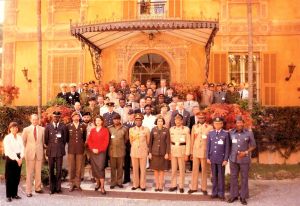 In 1970, the International Institute of Humanitarian Law was also founded, with its first headquarters at Villa Nobel and later Villa Ormond. The first president was the Honourable Paolo Rossi, then a member of the Constitutional Court, and the secretary was the judge of the Sanremo Court, Ugo Genesio.
In 1970, the International Institute of Humanitarian Law was also founded, with its first headquarters at Villa Nobel and later Villa Ormond. The first president was the Honourable Paolo Rossi, then a member of the Constitutional Court, and the secretary was the judge of the Sanremo Court, Ugo Genesio.
During his administration Pancotti also took a number of important initiatives, including an attempt to solve the problem of the city's precarious water supply by diverting the Roja aqueduct, a project that would later be carried out by his successor Parise, the proposal to throw the wrecked cars' carcasses into the sea in order to encourage fish nourishment, and the project to build a sports citadel with specialised clinics, centres for the elderly and university colleges for some faculties dependent on the University of Genoa in order to promote the revitalisation of the city.
However, on 17 April 1971, just six months after his appointment as first citizen, Mayor Pancotti was declared ineligible. The appeal against Pancotti, lodged by his fellow party members, concerned the installation of a chandelier in one of the Casino's halls, after which the professional had had his fee contested.
The result was a dispute that led to Pancotti's ineligibility, since, by law, candidates for election and municipal councillors could not have any kind of suspension with the body they were going to administer.
Together with the mayor, the Court of Appeal also declared ineligible the three Christian Democrat councillors Andrea Lolli, Lina Lanteri and Claudio Nicolini, the Social Democrat Pietro Armela, the Socialist Rinaldo Ferrero and the Liberal Giuseppe Rovere.
In May 1971 Pancotti resigned and was temporarily replaced by Christian Democrat Onorato Lanza, who acted as mayor until the following 5 June when the DC exponent Pietro Parise was elected mayor, who launched a council formed by, among others, five Christian Democrats, and, after the Socialists went into opposition the following October, also by a Liberal, a Social Democrat and a Republican.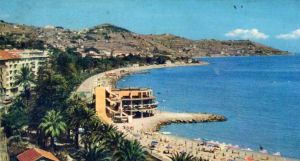 In August 1971 the City Council approved the project drawn up by Martolini and Piras for a new tourist port, the future Portosole, which was to be built on
In August 1971 the City Council approved the project drawn up by Martolini and Piras for a new tourist port, the future Portosole, which was to be built on  the Trento e Trieste promenade on the left bank of the Morgana, while on the following 9th November the section of the Autostrada dei Fiori between Sanremo and Bordighera was opened to traffic, thus connecting the extreme western Riviera with Savona and Genoa.
the Trento e Trieste promenade on the left bank of the Morgana, while on the following 9th November the section of the Autostrada dei Fiori between Sanremo and Bordighera was opened to traffic, thus connecting the extreme western Riviera with Savona and Genoa.
In the meantime, in October, there was a government reshuffle caused by the exit of the Socialists from the majority, later replaced by the Liberals, which also saw the appointment of the Christian Democrat Leone Pippione as councillor in place of the resigning Lanza.
In the summer of 1972 there was another scandal linked to the Casino: the ministerial commissioner of the San Remo Gaming House, Gaetano Fusco, denounced the fact that two billion lire a year was mysteriously disappearing from the gaming rooms, causing the prompt reaction of the employees and in particular of the croupiers, who proclaimed a strike protest that would last for thirteen days, during which they also marched to the Ariston Theatre where they held an assembly.
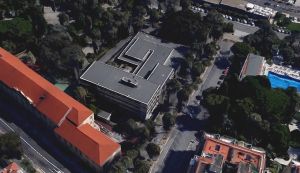 On 30 September 1972, in the presence of the Minister of Justice Guido Gonella, the new Palace of Justice in Via Anselmi was inaugurated, built on the
On 30 September 1972, in the presence of the Minister of Justice Guido Gonella, the new Palace of Justice in Via Anselmi was inaugurated, built on the 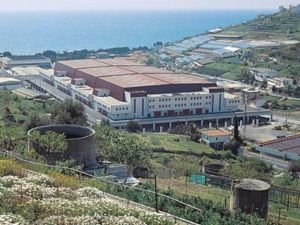 initiative of the Giunta Parise at a total cost of 500 million lire.
initiative of the Giunta Parise at a total cost of 500 million lire.
In 1972 the Unione Cooperativa Floricoltori della Riviera, UCFLOR, was also set up to coordinate the projects and initiatives of local flower producers and traders for the construction and management of the new Flower Market.
In the early months of 1973, the Parise Council risked collapsing because of the strong political friction that arose between the mayor and the councillor for tourism, Cavaliere, and between the latter and the councillor for property and personnel, Pippione, so much so that, in April, during a meeting of the Municipal Council, the mayor threatened to resign, but this was immediately withdrawn, perhaps due to the lack of a valid political alternative to the executive headed by Parise.
During 1973 the project for the Villa Ormond Conference Centre, designed by the architect Spadolini, brother of the Minister of Defence, was also approved, and Sanremo also felt the effects of the oil crisis, forcing thousands of citizens to queue for petrol and kerosene.
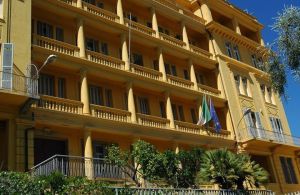 In the autumn of 1973, a new upper secondary school was founded in the town, the Liceo Scientifico "Girolamo Saccheri", which officially started school on 1 October of that year. It was housed in the former Excelsior hotel next to the 'Cassini' classical lyceum.
In the autumn of 1973, a new upper secondary school was founded in the town, the Liceo Scientifico "Girolamo Saccheri", which officially started school on 1 October of that year. It was housed in the former Excelsior hotel next to the 'Cassini' classical lyceum.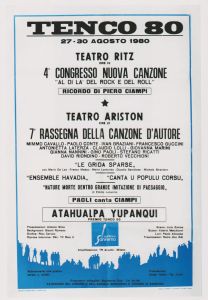 In 1974 the Sanremo floriculturist Amilcare Rambaldi, who had already conceived the Festival della canzone, after founding the "Club Tenco" in 1972, promoted a new singing event, the "Rassegna della Canzone d'Autore", which from that year onwards would be held uninterruptedly up to the present day with the participation of some of the best Italian and foreign singer-songwriters.
In 1974 the Sanremo floriculturist Amilcare Rambaldi, who had already conceived the Festival della canzone, after founding the "Club Tenco" in 1972, promoted a new singing event, the "Rassegna della Canzone d'Autore", which from that year onwards would be held uninterruptedly up to the present day with the participation of some of the best Italian and foreign singer-songwriters.
In May 1974 the referendum on the abrogation of divorce was held, which saw the victory of the divorce camp in Sanremo, where 74.31% of the inhabitants voted against its abrogation, despite the fact that during the months of the referendum campaign the leader of the anti-divorce camp and national secretary of the DC, Amintore Fanfani, came to town.
In the meantime, the municipal administration renewed the concession for the municipal waste collection and disposal service to the Docks Lanterna Company of Genoa, which would continue to manage the service for many years, while councillor Roberto Lardera presented a project for the construction of an Olympic sports village in Pian di Poma, which, although it had met with public approval, would never be realised.
On 2 December 1974, a national gathering of the partisans of the ANPI and the FIVL took place, culminating in a speech by the President of the Chamber of Deputies Sandro Pertini (future President of the Republic) in Piazza Colombo in front of thousands of citizens.
During his speech, which was applauded at length by the participants in the demonstration, Pertini praised the heroism of the men of the Resistance, in particular Brigadier Salvo D'Acquisto, harshly condemned the phenomenon of political corruption, and finally stigmatised the use of violence by the young protesters.
In January 1975, Minister of the Interior Gui, noting the substantial failure of the public management of the Casino, proposed for the first time that the San Remo Casino be entrusted to private owners.
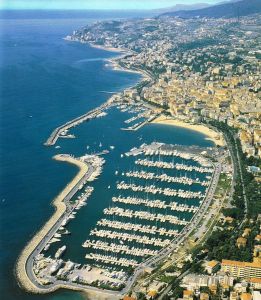 Towards the end of March 1975, on the other hand, work began on the construction of Portosole in the stretch of sea in front of the bathing establishments on the Trento e Trieste promenade between the Morgana and the RAI antenna, despite the fact that the ministerial authorities had preferred the Valmarina project, which envisaged the construction of a tourist port along the current Promenade delle Nazioni in front of the railway station.
Towards the end of March 1975, on the other hand, work began on the construction of Portosole in the stretch of sea in front of the bathing establishments on the Trento e Trieste promenade between the Morgana and the RAI antenna, despite the fact that the ministerial authorities had preferred the Valmarina project, which envisaged the construction of a tourist port along the current Promenade delle Nazioni in front of the railway station.
In the end, however, CNIS (Società Circolo Nautico Internazionale Sanremo), the contractor for the work, managed to obtain authorisation for the new structure in the area facing the Trento e Trieste promenade, thanks also to the support of the municipal authorities, especially Mayor Parise.
The Portosole port, officially opened in July 1977, was to become one of the most modern and welcoming tourist ports in the Mediterranean.
On May 3, 1975 the last meeting of the City Council was held before the local elections, in view of which the various parties began to prepare their lists of candidates, among which the New Sanremo list stood out, formed by the outgoing mayor Parise, the former Christian Democrat Filiberto Viani, as well as six other Christian Democrats and many former Liberals.
The elections of May 1975 confirmed the relative majority of the DC, which passed from 14,604 to 16,480 votes, recorded a good affirmation of the independent list Nuova Sanremo, which obtained seven councillors, and saw the highest electoral consensus of the PCI, which won 12,523 votes.
After lengthy negotiations, the leader of the DC group in the Municipal Council, Giovanni Parodi, succeeded in launching a council with the liberal Giuseppe Rovere as mayor, who took office in September 1975. Rovere was joined by the DC as councillors Osvaldo Vento, Gian Marco Cassini, Enrico Barba, Stefano Accinelli and Angelo Asseretto, who were joined by Fulvio Ballestra as Tourism Councillor, Gianfranco Cavalli and Enzo Ligato. In December, Parodi would then be replaced by Pippione as the new group leader of the Christian Democrat councillors.
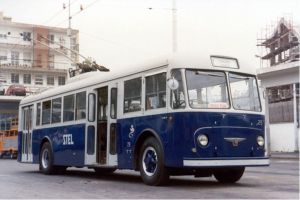 In October 1975, meanwhile, Mayor Rovere had set up a new municipal transport service, following the sudden decision of the STEL management to discontinue its public transport activities. This new service then became a real provincial public transport company with the establishment of the SPT (Società Provinciale dei Trasporti), later transformed into the current RT (Riviera Trasporti).
In October 1975, meanwhile, Mayor Rovere had set up a new municipal transport service, following the sudden decision of the STEL management to discontinue its public transport activities. This new service then became a real provincial public transport company with the establishment of the SPT (Società Provinciale dei Trasporti), later transformed into the current RT (Riviera Trasporti).
During the Rovere administration, the foundations were also laid for the upstream move and the doubling of the Ospedaletti-San Lorenzo al Mare section of the railway line, thanks above all to the commitment of the mayor, who succeeded, with the active collaboration of the liberal exponent Aldo Bozzi (former Minister of Transport from June 1972 to June 1973 in the second Andreotti government), in having the project included in the national railway restructuring plan, also setting up a special fund in the municipal budget of one billion a year for ten years, taken from the Casino's anti-retirement fund.
 In May 1976, the local television station TeleSanremo-Riviera dei Fiori had also begun broadcasting, on the initiative of a radiologist, Giovanni Lotti, and a mobile antenna operator (Costanzo Welber), while other sources report that the founder was the journalist Gianni Olivieri. For many years it was the only television network in Sanremo that was an alternative to RAI, until it was taken over by the Genoese 'Primo Canale' in 1984.
In May 1976, the local television station TeleSanremo-Riviera dei Fiori had also begun broadcasting, on the initiative of a radiologist, Giovanni Lotti, and a mobile antenna operator (Costanzo Welber), while other sources report that the founder was the journalist Gianni Olivieri. For many years it was the only television network in Sanremo that was an alternative to RAI, until it was taken over by the Genoese 'Primo Canale' in 1984.
In the same period Onorato Lanza succeeded Professor Enzo Specogna as political secretary of the Sanremo DC, while on June 20 political elections were held, which sanctioned the election as deputies of Christian Democrats Manfredo Manfredi of Imperia and Emidio Revelli of Taggia, and of the communist from Sanremo Franco Dulbecco, at that time town councillor in the Matuzian town, who thus became the second Sanremo deputy after Gino Napolitano.
In the meantime, the Rovere council was in crisis due to the DC's desire to reserve the position of mayor for its members and at the end of June 1976, the four Christian Democrat councillors Accinelli, Barba, Cassini and Vento resigned at the same time. At the same time, the Christian Democrat Parodi had reached an agreement with the Socialists to prevent Parise from ascending to the mayoral seat, and immediately afterwards Parodi blocked Pippione's attempt to become mayor. While Lanza renounced his candidacy for mayor, Parodi managed to get the majority to agree on Osvaldo Vento during an informal meeting at the Bar Parisienne.
The new Vento council, launched in November 1976, was then made up of the same councillors as the previous one, with the exception of Barba and Cassini, who were replaced by Asseretto and the lawyer Aldo Ferraro, but also included the socialists represented by the councillor for public works Bruno Marra.
In the same days as Mayor Vento took office, the Roja pipeline was inaugurated in Pian di Poma, which would finally bring large quantities of water to Sanremo, solving the chronic problem of the lack of water supply in the Matuzian town.
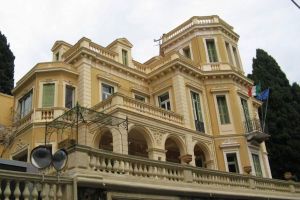 In the meantime, the Regional Institute for Floriculture was founded in the historic villa Bel Respiro in Corso Inglesi, in accordance with regional law no. 22 of 2 July 1976. This was an organisation managed by the Liguria Region which, in collaboration with other local authorities and trade associations, would have the task of promoting the multiplication of healthy and selected plants destined for Ligurian floricultural operators within the framework of a non-profit management system, while also carrying out a series of basic and applied research in the floricultural sector of regional interest.
In the meantime, the Regional Institute for Floriculture was founded in the historic villa Bel Respiro in Corso Inglesi, in accordance with regional law no. 22 of 2 July 1976. This was an organisation managed by the Liguria Region which, in collaboration with other local authorities and trade associations, would have the task of promoting the multiplication of healthy and selected plants destined for Ligurian floricultural operators within the framework of a non-profit management system, while also carrying out a series of basic and applied research in the floricultural sector of regional interest.
In February 1977, meanwhile, a crisis developed within the majority due to the defection of three Christian Democrat councillors, Lardera, Barba and Cavaliere, who were promptly replaced by three Communist exponents who were prepared to support the Vento Council from outside, thus shifting its centre of gravity to the left, as was also happening at national level.
In the following March, the hospital of Bussana was united with that of Sanremo, thus giving rise to the "Ospedali Riuniti".
In May, the trial was held against fifteen croupiers of the Casino, accused by Judge Squizzato of having stolen money from the Casino in cahoots with some customers. However, the public prosecutor asked for very light sentences, only three convictions and the acquittal for lack of evidence for all the other defendants, which were upheld in the sentence passed by the Court.
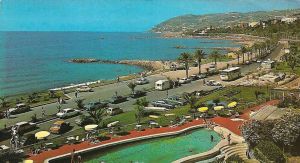 A few months later, the first batch of works for the construction of the Promenade of Nations, located along the sea in front of the railway station, was completed.
A few months later, the first batch of works for the construction of the Promenade of Nations, located along the sea in front of the railway station, was completed.
In March 1978 another municipal councillor, Christian Democrat Simonetti, resigned and was replaced by the first of the unelected, Dr Gianni Giuliano, who in the following legislature would also hold the post of councillor for Tourism.
During 1979 the socialists, social democrats and republicans also entered the majority, so that the opposition was made up only of the liberals, the missini and the independents of "Nuova Sanremo", while in the same year the city's political forces began to discuss the possibility of setting up a mixed company with public and private capital to manage the Sanremo Gaming House.
On 3 January 1980 the liberal councillor Gigi Semiglia denounced the fact that the Casino's overdraft facilities were granted by a lady who took advantage of her friendship with the president of the committee that managed the Casino, Egidio Lupi, to illegally grant overdraft facilities to the Casino's customers. The accusations made by Semiglia led to Lupi's resignation and he was replaced on the following 1 June by the accountant Antonio Semeria.
In the early months of 1980, the City Council approved the new general urban development plan, while in June the administrative elections were held, which sanctioned a new victory for the Christian Democrat exponents, who in the following October re-elected Osvaldo Vento as mayor for a second term, at the head of a council made up of the same councillors as the previous one. 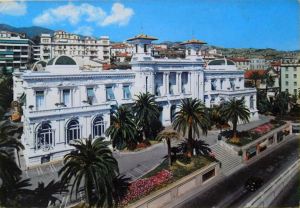 In the meantime, the president of the administrative commission in charge of controlling the Casino, Semeria, decided to adopt strict control measures designed to disrupt the widespread tendency towards organised crime that was thought to involve most of the Casino's employees. The first measure adopted by Semeria was to assign to himself the composition of the teams assigned to the various roulette tables, but the situation got worse when, at the end of August, a hired killer, later identified as the criminal Antonio Rosapinta, gunned down in Corso Mazzini the deputy director of the municipal controllers Luigi Garfì, punished because he was suspected of having suggested to Semeria to interfere in the composition of the teams in charge of controlling the games.
In the meantime, the president of the administrative commission in charge of controlling the Casino, Semeria, decided to adopt strict control measures designed to disrupt the widespread tendency towards organised crime that was thought to involve most of the Casino's employees. The first measure adopted by Semeria was to assign to himself the composition of the teams assigned to the various roulette tables, but the situation got worse when, at the end of August, a hired killer, later identified as the criminal Antonio Rosapinta, gunned down in Corso Mazzini the deputy director of the municipal controllers Luigi Garfì, punished because he was suspected of having suggested to Semeria to interfere in the composition of the teams in charge of controlling the games.
At the beginning of January 1981, Semeria continued his cleansing operation by sacking the director general of the games Stefano Carabalona and suspending the director of the chemin Angelo Semeria. However, the alleged corruption of the Casino's employees led the Sanremo magistracy a few days later to carry out a massive blitz, which was triggered at dawn on 27 January, during which two hundred policemen, carabinieri and financiers from Sanremo, Imperia, Ventimiglia, 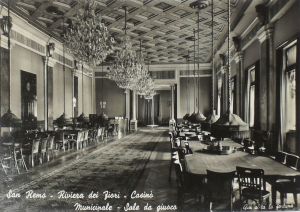 Genoa and Turin arrested eighteen croupiers and thirty clients in their homes, while the judicial authorities issued thirty-five judicial notices to as many suspected croupiers and clients.
Genoa and Turin arrested eighteen croupiers and thirty clients in their homes, while the judicial authorities issued thirty-five judicial notices to as many suspected croupiers and clients.
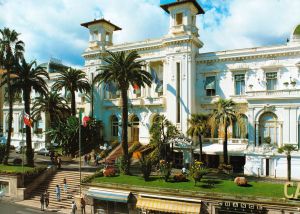 Immediately after the raid, the Casino was closed for three days. After the blitz, the Minister of the Interior, Virginio Rognoni, invited Mayor Vento to present a new management formula for the Sanremo casino, to be administered by private individuals, by April 1982, the date on which the gambling concession expired.
Immediately after the raid, the Casino was closed for three days. After the blitz, the Minister of the Interior, Virginio Rognoni, invited Mayor Vento to present a new management formula for the Sanremo casino, to be administered by private individuals, by April 1982, the date on which the gambling concession expired.
In the meantime, the circle of people involved in the judicial enquiry that followed the blitz in January 1981 was widening, so much so that by the following May the number of people indicted by the judiciary for the Casino scandal had reached one hundred and twenty, of whom one hundred and eighteen would be put on trial for theft and criminal conspiracy.
In the summer of 1981 the City Council decided to entrust the Casino, after fourteen years of municipal administration, to a private company, while a special commission, chaired by Christian Democrat councillor Roberto Andreaggi, was charged with examining the companies' bids for the contract.
Shortly afterwards, Leone Pippione took over as President of the Provincial Administration of Imperia and Antonio Semeria, Mayor Vento, former President Egidio Lupi and councillor Enzo Ligato were acquitted of the charge of dereliction of duty for failing to intervene promptly to prevent the thefts at the Casino.
At the beginning of December, the trial of the one hundred and eighteen croupiers and customers involved in the thefts at the Casino in the horse-riding shed in the Solaro area began.
On 23 December 1981 the president of the Casino's control commission, Antonio Semeria, finally resigned, which was immediately accepted by the Minister of the Interior.
On 19 March 1982 the Public Prosecutor in the Solaro trial, Rocco Blaiotta, asked for all the defendants to be sentenced to a total of five hundred years' imprisonment.
On the following 28 May, the Court, presided over by Renato Viale, sentenced 112 of the 112 defendants, six of whom were acquitted, to sentences ranging from a few months to eight years' imprisonment.
In the meantime, the commission to entrust the management of the Casino, chaired by the Cassation magistrate Domenico Riccomanno, had proceeded to choose the two private companies, Count Giorgio Borletti's Flowers Paradise and Michele Merlo's SIT, which were to compete for the contract to manage the Casino.
In October, the Municipality purchased the brand name of the Festival della Canzone from Bertolini's ATA at a price of 84 million lire, while at the same time the Russian Church was declared the property of the Community of Russian refugees, established in 1961.
On 22 January 1983, in the Sala Fiorentina of Palazzo Bellevue, the magistrate Riccomanno proclaimed Count Borletti's company the winner of the auction for the Casino's contract, having offered 18 billion 650 million a year against the 21 billion offered by the engineer Merlo.
Although he had offered much less, Borletti won the auction because Merlo's bid was 20 million more than the established ceiling of 20 billion 980 million.
However, immediately after the contract was awarded to Borletti, Merlo appealed against the outcome of the auction, while Borletti, since the Council was late in handing over the keys to the Casino, requested and obtained the conservative seizure of the Casino. After several months of appeals to the courts and expert opinions, on 9 August 1983 a meeting was held in the office of the President of the Sanremo Court, Viale, in the presence of Count Borletti, engineer Merlo and Mayor Vento, during which Borletti definitively renounced the management of the Casino, leaving the way open to Merlo.
The only thing missing at that time was the approval of Interior Minister Oscar Luigi Scalfaro, who, however, did not take any decision, but instead sent a long report to the Milanese magistrates investigating the casino, containing all the suspicions of corruption and the Mafia hanging over Merlo.
In November, the situation deteriorated and the Milanese magistrates ordered the arrest of Merlo, the members of the council commission on the Casino contract, Andreaggi and Accinelli, Mayor Vento, councillors Tommasini, Ligato, Covini, Cavalli and the leader of the DC group and regional councillor Giovanni Parodi, while councillors Giuliano and Carella managed to avoid arrest.
Later, the Milanese magistrates also issued an arrest warrant against businessman Augusto Poletti, a close friend of Merlo, and asked the Chamber of Deputies for permission to proceed against the Christian Democrat MP Manfredo Manfredi, who was then undersecretary to the Treasury, for violation of the law on public financing of political parties.
At the end of December, on the wave of extreme justicialism, the mayor of Imperia Scajola was even arrested, but was later acquitted of all charges as no evidence of guilt had been found against him.
A few months later, in May 1984, the examining magistrate of Milan ordered the arrest of Merlo's lawyer, Aldo Ferraro, while on 15 January of the following year, Count Borletti was also arrested.
In December 1983 the Ministry of the Interior, noting the dissolution of the Council due to the numerous arrests in November, dissolved the Municipal Council and appointed Enrichetta Stefanolo, an official of the Prefecture of Imperia, as Commissioner ad acta for urgent affairs. Shortly afterwards she was succeeded by the extraordinary commissioner Bruno Pastorella, who, assisted by the sub-commissioner Gabriele Perreca, would run the Municipal Administration until the elections of June 1984.
In the early months of 1984 Pastorella approved the detailed plan for the land works at Portosole.
In December 1983 the Minister of the Interior, Mr Scalfaro, also appointed Dr Ignazio Mongini as prefectural commissioner of the Casino, while the Honourable Emidio Revelli was instructed by the DC to see if it was possible to reshuffle the majority in the Council, or, if not, to organise the party with a view to early elections scheduled for June of the following year.
The elections of June 1984 saw once again the affirmation of the DC, which obtained 13,000 votes and fourteen councillors, against the ten councillors elected for the PCI, while the independent list of "Nuova Sanremo" was again quite successful, electing five councillors.
In September 1984, the City Council elected the Christian Democrat Leone Pippione as mayor, who launched a council formed by his fellow party members Guido Goya at Tourism, Bruno Giri at Town Planning, Stefano Asseretto at Floriculture and Antonio Sindoni at Heritage, by the Republican Raffaele Canessa, who was also deputy mayor, at Public Works, by the Socialist Carlo Conti at Social Services, by the Social Democrat Franco Solerio at Urban Police and by the Liberal Ulderico Sottocasa at the Budget.
Finally, on 27 December 1984, Sanremo was declared a seismic zone by the ministerial experts, who also obtained the result of definitively blocking the building sector, which had been in crisis for several years after the boom of the 1950s and 1960s.
In July 1986 Pippione resigned and was reconfirmed as mayor, but at the head of a council that saw the entry of the socialist Carlo Conti as deputy mayor and councillor for public works, the Christian Democrat Gian Marco Cassini as tourism councillor in place of Guido Goya, and the two Christian Democrats Agostino Carnevale and Andrea Gorlero, while the Republicans went into opposition.
In October 1987 Pippione resigned again and was then reconfirmed for a third term of office that lasted until the local elections of May 1989, which saw the DC emerge once again as the party with the relative majority. The following September, Pippione became mayor for the fourth time, which he held until May 1990.
From May 1990 to July of the same year, Antonio Sindoni acted as mayor until the Christian Democrat Onorato Lanza was elected mayor, who governed the municipality for two consecutive terms until August 1992.
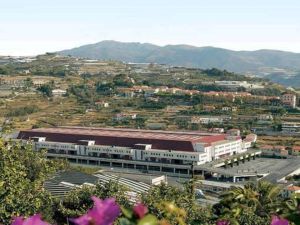 In the meantime, on 13th October 1990, the new headquarters of the Flower Market had been inaugurated, consisting of a large structure located in Valle Armea, the construction of which had begun in 1981 and was finally completed in 1992.
In the meantime, on 13th October 1990, the new headquarters of the Flower Market had been inaugurated, consisting of a large structure located in Valle Armea, the construction of which had begun in 1981 and was finally completed in 1992.
In August 1992 Raffaele Canessa was elected mayor and remained at the helm of the Municipality until May 1993 when the Prefect of Imperia Giuseppe Piccolo dissolved the Municipal Council for «manifest incapacity», appointing at the same time Elio Priore as extraordinary commissioner, assisted by Elio Landolfi as sub-commissioner.
In the meantime, the Italian electoral system was changed from proportional to majority, with traditional and even historic parties disappearing and completely new or renamed formations taking their place.
The intention was to give more stability to governments that had hitherto been numerous and subject to frequent crises.
This was also the case for the local administrations, especially the Regions and Municipalities, although, especially for the latter, this was not always the case.
In fact, on 21 November 1993 the first round of the new administrative elections was held, which provided for the direct election of the mayor. The largest number of votes went to the Northern League member Davide Oddo and the leader of "Sanremo Insieme" Luigi Ivaldi.
In the next runoff election, held on December 5, 1993, Oddo prevailed by a narrow margin over Ivaldi, who was supported by the entire centre-left group.
Oddo held the Civic Administration until April 1995, when, following a crisis that broke out within the Municipal Council, 17 councillors out of 30 resigned en bloc, inducing the following 12 May the President of the Republic Scalfaro to dissolve the Municipal Council and at the same time appointing Pasquale Gioffré as extraordinary commissioner for the provisional management of the Municipality of Sanremo, who was succeeded the following month by the former Prefect of Imperia Giuseppe Piccolo, assisted by the sub-commissioner Landolfi.
On 19 November 1995, the first round of local elections was held, with the candidate of the Polo delle Libertà (Forza Italia, Alleanza Nazionale, CCD and CDU) Giovenale Bottini and the centre-left candidate Andrea Gorlero going to the ballot. Bottini prevailed by a wide margin in the subsequent runoff election on 3 December, launching a council comprising in particular Giovanni Berrino, as deputy mayor and councillor for Budget, Heritage and Finance, Antonio Bissolotti for Tourism and Events, Giuseppe Cugge for Public Works, Vincenzo Lanteri for Social Security, Franco Erasmi for Urban Planning, and Claudio Bagnoli for Floriculture and Production Activities.
 Among the various important initiatives taken by the municipal administrations in the early 1990s, of particular importance was the opening to traffic in 1994 of the Aurelia bis section from Valle Armea to the San Martino district, which was then extended to the Ospedale Civile in 1997, providing a valid alternative to the Aurelia, which was increasingly congested with traffic.
Among the various important initiatives taken by the municipal administrations in the early 1990s, of particular importance was the opening to traffic in 1994 of the Aurelia bis section from Valle Armea to the San Martino district, which was then extended to the Ospedale Civile in 1997, providing a valid alternative to the Aurelia, which was increasingly congested with traffic.
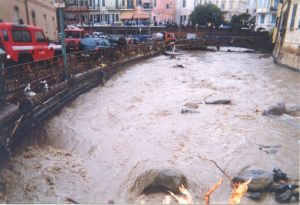 In
In 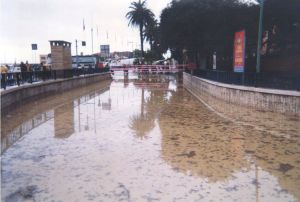 recent years, however, there has also been an extremely mournful event for the city: the flood of 30 September 1998, which claimed one victim, Maria Lisa Lupi, killed by a wave of water and mud in Via Duca degli Abruzzi, and caused damage to property and movable assets estimated at hundreds of billions of lire.
recent years, however, there has also been an extremely mournful event for the city: the flood of 30 September 1998, which claimed one victim, Maria Lisa Lupi, killed by a wave of water and mud in Via Duca degli Abruzzi, and caused damage to property and movable assets estimated at hundreds of billions of lire.
Finally, on 16 April 2000, a new round of administrative elections was held for the election of the mayor and the renewal of the municipal council. The elections resulted in a landslide victory for the outgoing mayor Giovenale Bottini at the head of a centre-right coalition formed by Forza Italia, Alleanza Nazionale, CCD and Lega Nord, who won with 71.7% of the votes against 14, 5 of the candidate of the DS, SDI, Rifondazione Comunista Comunisti Italiani Stefania Russo, 12.3 of Daniela Cassini, supported by the Democratici, PPI, Verdi and the civic list "Sanremo Insieme", and 1.5% of the candidate of the Alleanza Monarchica Rosella Amoroso.
The new Council is therefore composed of the reconfirmed Berrino, who also maintained the post of deputy mayor, at the Budget and Taxes, Bissolotti at Tourism, Lanteri at Social Policies and Bagnoli at Economic Development, and the new councillors Giorgio Silvano at Public Works, Mario Ferrandini as regards Town Planning, Franco Solerio as regards Personnel, Antonio Sindoni as regards Property and Demographic Services, Carlo Alberto Nebbia Colomba as regards Quality of Life and Marco Lupi as regards Soil Defence, Hydrogeological Rehabilitation and Relations with Decentralised Bodies and Hamlets.
On 18 September 2001, the new company Casinò Spa was set up to manage the Matuzian casino, with capital shared between the Municipality of Sanremo, 80%, and the Province of Imperia, 20%.
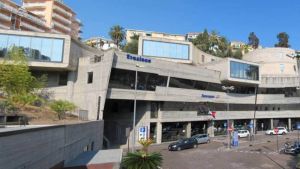
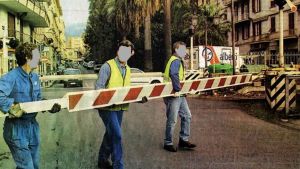 On the following 27 September, the upstream shift and doubling of the railway line in the San Lorenzo al Mare-Ospedaletti section was completed, with the simultaneous opening of the new underground station at Sanremo and the removal of all the barriers obstructing free passage to the sea.
On the following 27 September, the upstream shift and doubling of the railway line in the San Lorenzo al Mare-Ospedaletti section was completed, with the simultaneous opening of the new underground station at Sanremo and the removal of all the barriers obstructing free passage to the sea.
The following year, the Area24 company was set up to reuse the land and buildings of the former railway line.
On 1 December 2003, Mayor Bottini had to resign following the outbreak of the Academy of Song scandal, which allegedly also involved the Councillor for Tourism Antonio Bissolotti. Both were later cleared of all charges, but their political careers were compromised. The Prefect of Imperia therefore dissolved the municipal council and appointed Elio Maria Landolfi as extraordinary commissioner.
In the following elections in June 2004, the centre-left candidate Claudio Borea was elected mayor, defeating the centre-right candidate Gianni Rolando.
In 2006, Sanremo prosecutor Mariano Gagliano had Luigi Tenco's body exhumed. Three years later, however, Gagliano dismissed the case as a suicide.
In 2008 the municipal council was dissolved, and on 28 November Umberto Calandrella was appointed extraordinary commissioner.
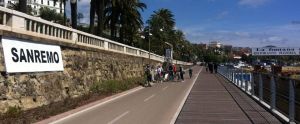 Also in 2008, the "Pista ciclo-pedonale del Parco costiero della Riviera dei Fiori" (the cycle-pedestrian path of the Riviera dei Fiori coastal park) was inaugurated along the former railway line between San Lorenzo al Mare and Ospedaletti.
Also in 2008, the "Pista ciclo-pedonale del Parco costiero della Riviera dei Fiori" (the cycle-pedestrian path of the Riviera dei Fiori coastal park) was inaugurated along the former railway line between San Lorenzo al Mare and Ospedaletti.
In June 2009, Maurizio Zoccarato, a member of the Popolo della Libertà party, became mayor.
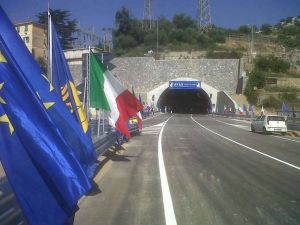 In 2011 the last section of the Aurelia-bis was opened from the hospital to the Borgo area. In addition to Mayor Zoccarato, the inauguration was also
In 2011 the last section of the Aurelia-bis was opened from the hospital to the Borgo area. In addition to Mayor Zoccarato, the inauguration was also 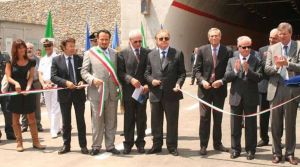 attended by the Minister of Infrastructure and Transport, Altero Matteoli, MP Claudio Scajola, the President of the Region Claudio Brlando and the President of the Province Luigi Sappa.
attended by the Minister of Infrastructure and Transport, Altero Matteoli, MP Claudio Scajola, the President of the Region Claudio Brlando and the President of the Province Luigi Sappa.
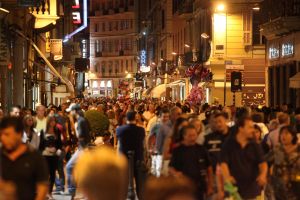 The following year the first stretch of Via Matteotti between the Ariston Theatre and Via Feraldi was pedestrianised, while in 2011 the second stretch from the Teatro Centrale to the Casino would also become a pedestrian precinct.
The following year the first stretch of Via Matteotti between the Ariston Theatre and Via Feraldi was pedestrianised, while in 2011 the second stretch from the Teatro Centrale to the Casino would also become a pedestrian precinct.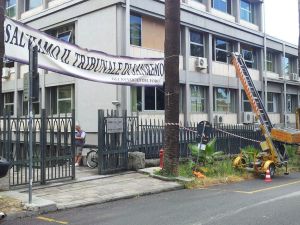 In September 2013, the Tribunal of Sanremo was abolished despite opposition from local authorities and protests from lawyers' associations.
In September 2013, the Tribunal of Sanremo was abolished despite opposition from local authorities and protests from lawyers' associations.
In June 2014 Alberto Biancheri was elected mayor, at the head of a centre-left coalition.
On 22 October 2015, thirty-five municipal employees were arrested in the municipality during a raid conducted by the Guardia di Finanza as part of the investigation into the so-called "card cheats". The images of some of the 'card cheats' went around the world and were long held up as an example of malfunctioning of the Public Administration. However, although some were fired, most were cleared of the charges.
In September 2017 Biancheri carried out a reshuffle of his council with the replacement of three councillors.
On 6 December 2017 Sanremo was named "European City of Sport 2018" by the European Parliament in Brussels.
Among the most important results achieved by the Biancheri Administration, it is worth mentioning the connection of San Romolo, in December 2018, to the municipal aqueduct.
In the May 2019 elections, Alberto Biancheri was re-elected mayor for a second term, beating the centre-right candidate Sergio Tommasini in the first round.
Today Sanremo, despite a thousand difficulties, looks to the future with particular optimism, confident in its undisputed potential as a cutting-edge tourist centre capable of adequately addressing the demanding challenges of the new technological and multi-ethnic era. In particular, the city is going through a period of general redevelopment in an attempt to counteract a decline in tourism that began in the mid-1990s and to relaunch itself in terms of culture, history and landscape.
(Sources: from texts "Storia della Città di Sanremo" and "Aggiornamenti dal 1980 al 2000" as well as "Storia Tascabile di Sanremo" by Andrea Gandolfo; other authors; images from private archives and the Web)
Previous Part 10




